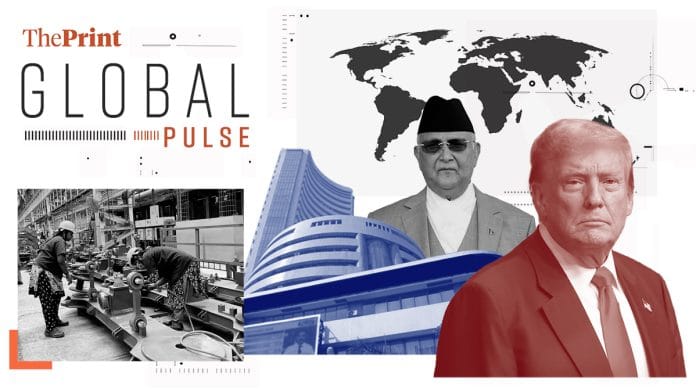New Delhi: Following the American elections, global media has been dissecting what the return of a Trump presidency could mean for the world, prompting a fresh look at the global economy—and India is no exception.
India is undergoing an “astonishing stock market revolution,” according to The Economist. Calling the Indian stock market the largest-ever “experiment in participatory capitalism,” the piece says that barriers to entry have fallen so much that one in five households now holds shares, with roughly 100 million people barely above the poverty line now becoming capitalists by owning stakes in publicly traded companies.
UPI and electronic brokers have helped drive the change: the digital shift has also led to an investment shift. The share of household assets held in bank accounts has fallen below half, the story says. Mutual funds seem to be the preferred choice—the number of SIP accounts has increased from 10 million to 99 million in the past eight years—and demat accounts have also risen. The most extreme indicator of investment mania is derivatives trading: India now accounts for 80 percent of global turnover, the piece says. It also points at how a small bike dealership was oversubscribed 400 times in its modest IPO. ThePrint had profiled the dealership.
But the fact that most are first-time investors should ring alarm bells—it poses a threat to financial stability.
“Indian regulators are growing increasingly uncomfortable,” The Economist writes. “ There are many reasons to applaud the vibrancy and increasing inclusiveness of India’s capital market. A possible bubble could provide harsh lessons on valuation, though—at the expense of the small investors who just arrived.”
India’s GDP poised to overtake Japan’s
The Japan Times reports that India’s GDP could soon overtake Japan’s, which could happen as soon as 2025 according to the IMF. S&P Global Rankings thinks the switch could happen in 2030. Economic stagnation and a weak yen are the reasons why.
Japan was the world’s second-largest economy until China overtook it in 2010. Germany, too, surpassed it earlier this year, leaving it in fourth place. The race is close with India: in 2023, India’s GDP was $3.55 trillion compared with Japan’s $4.22 trillion.
“Japan has been in and out of recession and fighting deflation for decades, while India has been on a steady climb higher since about 2000,” The Japan Times reports.
But the election of Trump means huge disruptions in trade flows and economic growth, and its impact is not yet clear for India or Japan. Plus, Japan now has a hawkish central bank—meaning higher interest rates—and a potentially less decisive minority government.
“Economists note that the rise of India is very much a matter of scale and that nominal rise of GDP should be kept in perspective,” the piece says. “Any economic troubles in India could also hit its growth or its currency hard and change the timeline significantly.”
Tamil Nadu’s manufacturing boom
In a piece in the Financial Times, former chief economic adviser Arvind Subramaniam looks at how Tamil Nadu is experiencing a manufacturing boom with the likes of Foxconn, Ford, Nike, Feng Tay, Cisco setting up base in the state—which ThePrint has also reported on extensively. The piece offers lessons for the rest of India, exploring exactly how Tamil Nadu cracked the code.
The state was able to tap highly educated labour pools—especially women—which manufacturing multinationals could use to tick off their diversity, equity and inclusion (DEI) requirements. Plus, it has created the perception that the state is a “relatively easy place to do business”—besides offering generous incentives to investors, it has a reactive policy framework that tries to minimise risk to them.
“If India is to develop its manufacturing sector, this Tamil Nadu experience must be replicated in the poorer, populous heartland states of Uttar Pradesh, Bihar, Rajasthan and Madhya Pradesh, with their cheaper labour pools,” Subramaniam writes. “To be sure, the governance challenges will be immense and India’s geopolitical window will not remain open forever. But the model is there for emulation.”
Nepal & India’s ‘Monroe Doctrine’
Global Times has something to say about Nepal’s prime minister, K.P. Sharma Oli, choosing China over India for his first bilateral visit abroad after taking power.
“Rather than lamenting the choices of a sovereign nation regarding its diplomatic engagements, this so-called ‘break from tradition’ should prompt India to reflect on why China is increasingly welcomed among South Asian countries,” it quotes a Chinese expert as saying.
While the visit hasn’t yet been confirmed by Chinese authorities, The Kathmandu Post reported that it would likely focus on the implementation of past agreements and accords. Global Times quotes Indian media as reporting Oli’s visit was a “symptom of strain” in India-Nepal ties, before ticking off a list of conflicts: India’s objection to Chinese investments in Nepal, and tensions over additional flight routes in newly built airports in Nepal.
“India’s excessive attention on the choices of state visit made by Nepal, an independent country, not only reflects India’s disregard for Nepal’s sovereignty but also demonstrates India’s Monroe Doctrine mentality of treating South Asian countries as its backyard,” the piece quotes Qian Feng, director of the research department at the National Strategy Institute at Tsinghua University, as saying.
The Monroe Doctrine is a traditional pillar of US foreign policy, named after 19th-century president James Monroe, who first articulated it. Attempting to establish a sphere of influence in the Western Hemisphere, it said the US would treat any interference by a European power in the affairs of any sovereign state in the Americas as a hostile act.






